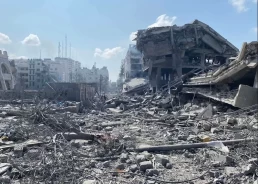While airstrikes account for mass casualties, bulldozers and explosives are flattening Gaza from the ground — what soldiers say is a systematic campaign to make the Strip unlivable, a joint investigation reveals.
By Meron Rapoport and Oren Ziv, +972 Magazine
In early April, just weeks after resuming its assault on Gaza, Israeli forces announced that they had taken control of the southernmost city of Rafah to create the “Morag Axis,” a new military corridor further dissecting the Strip. Over the course of the war, according to Gaza’s Government Media Office, the army had destroyed more than 50,000 housing units in Rafah — 90 percent of its residential neighborhoods. Now, the army proceeded to flatten Rafah’s remaining structures, turning the entire city into a buffer zone and cutting off Gaza’s only border crossing with Egypt.
Y., a soldier who recently returned from reserve duty in Rafah, described the army’s demolition methods to +972 Magazine and Local Call. “I secured four or five bulldozers [from another unit], and they demolished 60 houses per day. A one or two story house, they take down within an hour; a three or four-story house takes a bit longer,” he said. “The official mission was to open a logistical route for maneuvering, but in practice, the bulldozers were simply destroying homes. The southeastern part of Rafah is completely destroyed. The horizon is flat. There is no city.”
Y.’s testimony is consistent with those of 10 other soldiers who served at different times in the Gaza Strip and southern Lebanon since October 7, and who spoke with +972 Magazine and Local Call. It also aligns with videos published by other soldiers, on-the-record and off-the-record statements from current and former senior officers, satellite image analysis, and reports by international organizations.

Together, these sources paint a clear picture: the systematic destruction of residential buildings and public structures has become a central part of the Israeli army’s operations, and in many cases, the primary objective.
Some of this devastation is the result of aerial bombardments, ground fighting, and IEDs planted by Palestinian militants inside buildings in Gaza. However, while it is difficult to obtain precise figures, it appears that most of the destruction in Gaza and southern Lebanon was not carried out from the air or during combat, but rather by Israeli bulldozers or explosives — premeditated and intentional acts.
According to +972 and Local Call’s investigation, this was driven by a conscious, strategic decision to “flatten the area,” to ensure that “the return of people to these spaces is not something that will happen,” as Yotam, who served as a deputy company commander in an armored brigade in Gaza, said.
Recent Posts
The “President Of Peace” Prepares For War
December 23, 2025
Take Action Now The Donroe Doctrine Hits HomeBy William D. Hartung, Tom Dispatch Earlier this month, the Trump administration released its new…
“Who Are They Protecting?”: Rep. Ro Khanna Urges Contempt Charges Over AG Bondi’s Epstein Redactions
December 22, 2025
Take Action Now “The House can act unilaterally on contempt, and this will be introduced by Thomas Massie. What the resolution will say is that…
Dems Demand Answers as Trump Photo Disappears From DOJ Online Epstein Files
December 21, 2025
Take Action Now “What else is being covered up?”By Brett Wilkins, Common Dreams Congressional Democrats on Saturday pressed US Attorney General…
Elon Musk Is Vowing Utopia Driven by AI and Robotics. Bernie Sanders Has a Few Questions
December 20, 2025
Take Action Now “I look forward to hearing about how you and your other oligarch friends are going to provide working people with a magnificent life…




